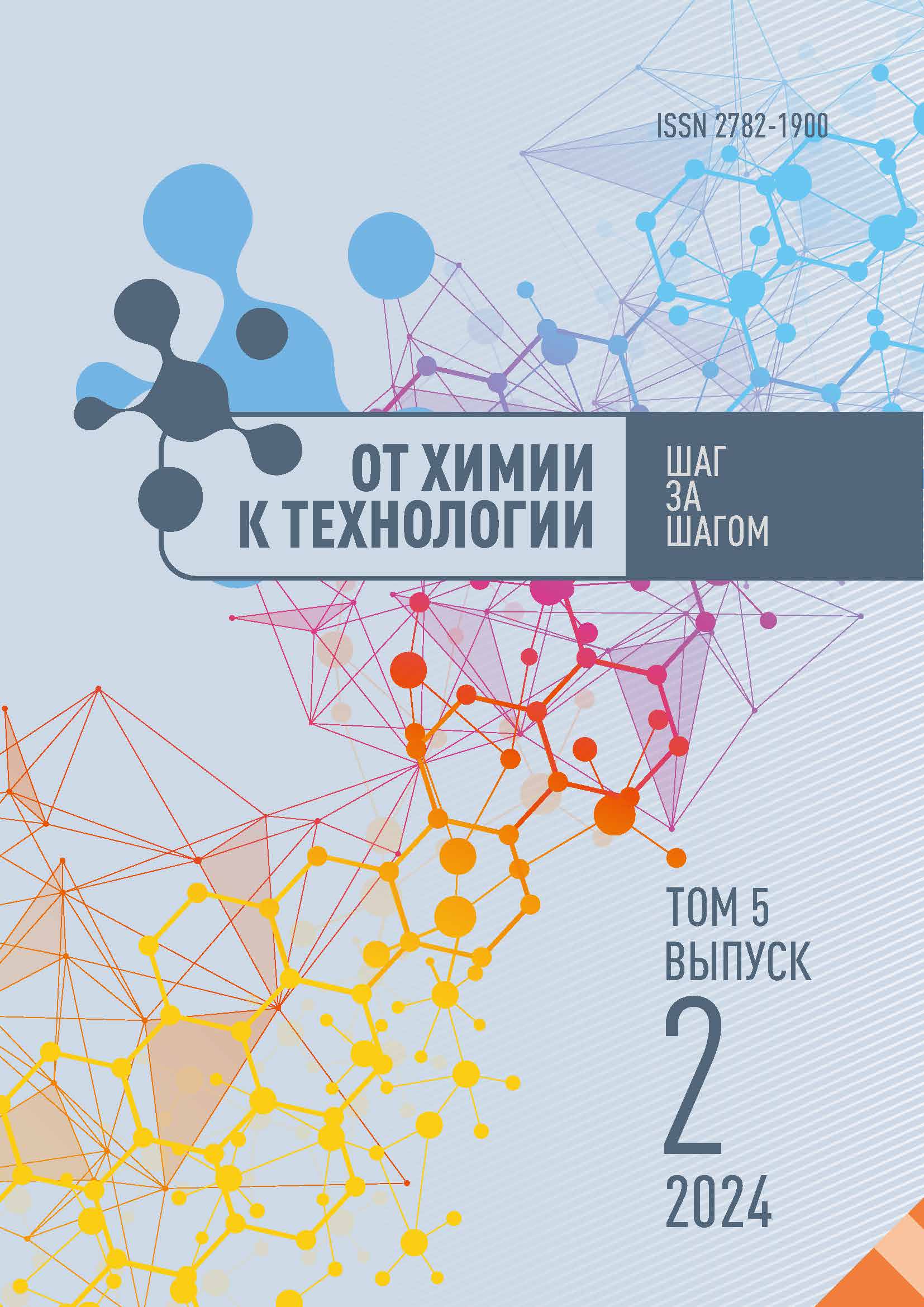Ярославль, Ярославская область, Россия
Ярославль, Ярославская область, Россия
Ярославль, Ярославская область, Россия
Ярославль, Ярославская область, Россия
Ярославль, Ярославская область, Россия
УДК 546.723 Трехвалентное железо
To clarify the charge compensation mechanism and the way of alloying additives placement, the authors synthesised samples of potassium βʺ-polyferrites with a wide range of mole fraction of introduced doubly charged cations. For these samples, the authors measured the electronic conductivity, cationic conductivity, and performed X-ray diffraction (XRD) analysis. The authors identified the charge compensation mechanism in potassium β″-polyferrite when doped with divalent ions of calcium, strontium, magnesium, and zinc. The charge compensation mechanisms differ depending on the radius of the introduced doubly charged ion. The results of cationic conductivity measurements of potassium β″-polyferrites show the mobility reduction of large calcium and strontium cations of potassium ions. Such additives are quite promising for improving the mechanical strength and thermal stability of the catalyst granules. They also increase the chemical stability of the contact granules. Corrosion resistance of pellets is a critical parameter. It determines the period of effective functioning of the catalyst. The data on electronic conductivity allow one to conclude that the introduction of Mg2+, Zn2+ cations sharply reduces the electron exchange in the structure of potassium β″-polyferrite. This should inevitably cause deactivation of the catalyst, while Ca2+ and Sr2+ ions do not reduce the electron transfer rate. Moreover, using the proposed approach will intensify the research process.
polyferrite, promoter, doubly charged cation, charge compensation, electronic conductivity, cationic conductivity, iron oxide catalyst
1. Joseph, Y., Ketteler, G., Kuhrs, C., Ranke, W., Weiss, W. & Schlögl, R. (2001) On the Preparation and Composition of Potassium Promoted Iron Oxide Model Catalyst Films, Phys. Chem. Chem. Phys., 18(3), pp. 4141-4153. DOI:https://doi.org/10.1039/B104263G.
2. Ketteler, G., Ranke, W. & Schlögl, R. (2002) Potassium-Promoted Iron Oxide Model Catalyst Films for the Dehydrogenation of Ethylbenzene: An Example for Complex Model Systems, Journal of Catalysis, 212(1), pp. 104-111 [online]. Available at: https://doi.org/10.1006/jcat.2002.3785
3. Dvoretskii, N.V., Anikanova, L.G. & Malysheva, Z.G. (2018) Types of active centers on surface of promoted iron oxide catalyst, Izv. vuzov. Khimiya i khim. tekhnologiya, 61(6), pp. 61-68 [online]. Available at: http://dx.doi.org/10.6060/tcct.20186106.5658 (in Russian).
4. Kotarba, A., Kruk, I. & Sojka, Z. (2002) Energetics of Potassium Loss from Styrene Catalyst Model Components: Reassignment of K Storage and Release Phases, Journal of Catalysis, 211(1), pp. 265-272 [online]. Available at: https://doi.org/10.1006/jcat.2002.3725
5. Anikanova, L.G. & Dvoretskii, N.V. (2016) Stabilization of Alkali Promoters in Structure of the Iron Oxide Dehydrogenation Catalysts, Kataliz v promyshlennosti, 8(2), pp. 145-151 [online]. Available at: http://dx.doi.org/10.18412/1816-0387-2016-1-29-36 (in Russian).
6. Kotarba, A., Rożek, W., Serafin, I. & Sojka, Z. (2007) Reverse Effect of Doping on Stability of Principal Components of Styrene Catalyst: KFeO2 and K2Fe22O34, Journal of Catalysis, 247(2), pp. 238-244 [online]. Available at: https://doi.org/10.1016/j.jcat.2007.02.009 (accessed 11.02.2024).
7. Meima, G.R. & Menon, P.G. (2001) Catalyst Deactivation Phenomena in Styrene Production, Applied Catalysis A: General, 212, pp. 239-245 [online]. Available at: https://ru.scribd.com/document/342010350/Catalyst-Deactivation-Phenomena-in-Styrene (accessed 11.02.2024).
8. Anikanova, L.G. & Dvoretskii, N.V. (2012) Distribution of Alkaline Promoters within the Structure of Iron Oxide Catalyst for Dehydrogenation, Kataliz v promyshlennosti, 4(4), pp. 307-312. DOI:https://doi.org/10.1134/S2070050412040022 (in Russian).
9. Abe, K., Ohshima, M., Kurokawa, H. & Miura, H. (2010) Effect of addition of Ce to Fe-K mixed oxide catalyst in dehydrogenation of ethylbenzene, Journal of the Japan Petroleum Institute, 53(2), pp. 89-94. DOI:https://doi.org/10.1627/jpi.53.89.
10. Abe, K., Kano, Yu., Ohshima, M., Kurokawa, H. & Miura, H. (2011) Effect of adding Mo to Fe-Ce-K mixed oxide catalyst on ethylbenzene dehydrogenation, Journal of the Japan Petroleum Institute, 54(5), pp. 338-343. DOI:https://doi.org/10.1627/jpi.54.338.
11. Nariki, S., Ito, S., Uchinokura, K. & Yoneda, N. (1988) Formation of -, -and -Alumina Type Ferrites in Rb2O-Fe2O3 and Cs2O-Fe2O3 Systems and Ionic Conduction of - and - Phases, Journal of the Ceramic Society of Japan, 96(1110), pp. 186-192 [online]. Available at: https://doi.org/10.2109/jcersj.96.186 (accessed 10.02.2024).
12. Anikanova, L.G. & Dvoretsky, N.V. (2020) Effect of Doubly Charged Ion Additives on the Activity and Chemical Stability of Catalytically Active Potassium Ferrites, Kataliz v promyshlennosti, 12(3), pp. 201-206. DOI:https://doi.org/10.1134/s2070050420030022(in Russian).
13. Bugaenko, L.T., Ryabykh, S.M. & Bugaenko, A.L. (2008) Almost complete system of average ionic crystallographic radii and its use for determining ionization potentials, Vestn. mosk. un-ta. Ser. 2. Khimiya, 49(6), pp. 363-384 [online]. Available at: https://cyberleninka.ru/article/n/pochti-polnaya-sistema-srednih-ionnyh-kristallograficheskih-radiusov-i-ee-ispolzovanie-dlya-opredeleniya-potentsialov-ionizatsii/viewer (accessed 12.02.2024) (in Russian).
14. Dvoretskaya, A.N., Anikanova, L.G., Sudzilovskaya, T.N., Malysheva, Z.G. & Dvoretskiy, N.V. (2023) Formation of a ceramic structure of promoted iron oxide catalyst, From Chemistry Toward Technology Step-By-Step, 4(3), pp. 60-68 [online]. Available at: https://doi.org/10.52957/2782-1900-2024-4-3-60-68 (accessed 21.02.2024) (in Russian).







